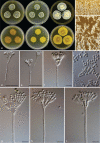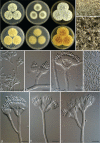A re-evaluation of Penicillium section Canescentia, including the description of five new species
- PMID: 35935896
- PMCID: PMC9311393
- DOI: 10.3767/persoonia.2021.46.06
A re-evaluation of Penicillium section Canescentia, including the description of five new species
Abstract
A survey of Penicillium in the fynbos biome from South Africa resulted in the isolation of 61 species of which 29 were found to be new. In this study we focus on Penicillium section Canescentia, providing a phylogenetic re-evaluation based on the analysis of partial beta-tubulin (BenA), calmodulin (CaM) and RNA polymerase II second largest subunit (RPB2) sequence data. Based on phylogenies we show that five fynbos species are new and several previously assigned synonyms of P. canescens and P. janczewskii should be considered as distinct species. As such, we provide descriptions for the five new species and introduce the new name P. elizabethiae for the illegitimate P. echinatum. We also update the accepted species list and synonymies of section Canescentia species and provide a review of extrolites produced by these species. Citation: Visagie CM, Frisvad JC, Houbraken J, et al. 2021. A re-evaluation of Penicillium section Canescentia, including the description of five new species. Persoonia 46: 163-187. https://doi.org/10.3767/persoonia.2021.46.06.
Keywords: DNA barcodes; Genealogical Concordance; Phylogenetic Species; Recognition (GCPSR); new taxa; secondary metabolites; series Atroveneta; series Canescentia.
© 2021 Naturalis Biodiversity Center & Westerdijk Fungal Biodiversity Institute.
Figures










Similar articles
-
A review of recently introduced Aspergillus, Penicillium, Talaromyces and other Eurotiales species.Stud Mycol. 2024 Mar;107:1-66. doi: 10.3114/sim.2024.107.01. Epub 2024 Jan 10. Stud Mycol. 2024. PMID: 38600958 Free PMC article.
-
A phylogenetic revision of Penicillium sect. Exilicaulis, including nine new species from fynbos in South Africa.IMA Fungus. 2016 Jun;7(1):75-117. doi: 10.5598/imafungus.2016.07.01.06. Epub 2016 Jun 1. IMA Fungus. 2016. PMID: 27433442 Free PMC article.
-
Phylogeny and nomenclature of the genus Talaromyces and taxa accommodated in Penicillium subgenus Biverticillium.Stud Mycol. 2011 Nov 15;70(1):159-83. doi: 10.3114/sim.2011.70.04. Stud Mycol. 2011. PMID: 22308048 Free PMC article.
-
Phylogeny of Penicillium and the segregation of Trichocomaceae into three families.Stud Mycol. 2011 Nov 15;70(1):1-51. doi: 10.3114/sim.2011.70.01. Stud Mycol. 2011. PMID: 22308045 Free PMC article.
-
Taxonomy of Penicillium section Citrina.Stud Mycol. 2011 Nov 15;70(1):53-138. doi: 10.3114/sim.2011.70.02. Stud Mycol. 2011. PMID: 22308046 Free PMC article.
Cited by
-
New and interesting species of Penicillium (Eurotiomycetes, Aspergillaceae) in freshwater sediments from Spain.MycoKeys. 2022 Feb 1;86:103-145. doi: 10.3897/mycokeys.86.73861. eCollection 2022. MycoKeys. 2022. PMID: 35145339 Free PMC article.
-
New Bioactive β-Resorcylic Acid Derivatives from the Alga-Derived Fungus Penicillium antarcticum KMM 4685.Mar Drugs. 2023 Mar 14;21(3):178. doi: 10.3390/md21030178. Mar Drugs. 2023. PMID: 36976227 Free PMC article.
-
Differences in Metabolite Profiles and Bioactivities of Intra-Strain Variants of Marine Fungus Penicillium antarcticum KMM 4668.Metabolites. 2025 Jan 27;15(2):77. doi: 10.3390/metabo15020077. Metabolites. 2025. PMID: 39997702 Free PMC article.
-
Two new species of Penicillium (Eurotiales, Aspergillaceae) from China based on morphological and molecular analyses.MycoKeys. 2025 Apr 25;116:255-274. doi: 10.3897/mycokeys.116.149376. eCollection 2025. MycoKeys. 2025. PMID: 40321907 Free PMC article.
-
New and Interesting Fungi. 7.Fungal Syst Evol. 2024 Jun;13:441-494. doi: 10.3114/fuse.2024.13.12. Epub 2024 Jul 17. Fungal Syst Evol. 2024. PMID: 39135884 Free PMC article.
References
-
- Alapont C, López-Mendoza MC, Gil JV, et al. . 2014. Mycobiota and toxigenic Penicillium species on two Spanish dry-cured ham manufacturing plants. Food Additives & Contaminants: Part A 31: 93–104. - PubMed
-
- Alfaro C, Urios A, González MC, et al. . 2003. Screening for metabolites from Penicillium novae-zeelandiae displaying radical-scavenging activity and oxidative mutagenicity: Isolation of gentisyl alcohol. Mutation Research - Genetic Toxicology and Environmental Mutagenesis 539: 187–194. - PubMed
-
- Allsopp N, Olivier DL, Mitchell DT. 1987. Fungal populations associated with root systems of proteaceous seedlings at a lowland fynbos site in South Africa. South African Journal of Botany 53: 365–369.
-
- Assamoi AA, Destain J, Delvigne F, et al. . 2008a. Improvement of xylanase production by Penicillium canescens 10-10c in solid-state fermentation. Pentoses dérivés de la biomasse. Biotechnology, Agronomy, Society and Environment 12: 111–118.
LinkOut - more resources
Full Text Sources
Research Materials
